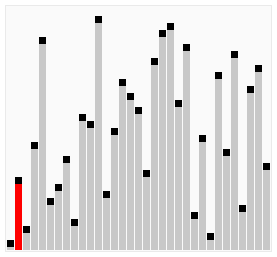
(Python Example for Citizen Data Scientist & Business Analyst)
Write a Python program to sort a list of elements using Cocktail shaker sort.
From Wikipedia, Cocktail shaker sort,[1] also known as bidirectional bubble sort,[2] cocktail sort, shaker sort (which can also refer to a variant of selection sort), ripple sort, shuffle sort,[3] or shuttle sort, is a variation of bubble sort that is both a stable sorting algorithm and a comparison sort. The algorithm differs from a bubble sort in that it sorts in both directions on each pass through the list. This sorting algorithm is only marginally more difficult to implement than a bubble sort, and solves the problem of turtles in bubble sorts. It provides only marginal performance improvements, and does not improve asymptotic performance; like the bubble sort, it is not of practical interest (insertion sort is preferred for simple sorts), though it finds some use in education.
Visualization of shaker sort:

Sample Solution:
Python Code:
Sample Output:
Input comma separated numbers: 15, 37, 69, 26, 78 [15, 26, 37, 69, 78]
Write a Python program to sort a list of elements using Cocktail shaker sort
Disclaimer: The information and code presented within this recipe/tutorial is only for educational and coaching purposes for beginners and developers. Anyone can practice and apply the recipe/tutorial presented here, but the reader is taking full responsibility for his/her actions. The author (content curator) of this recipe (code / program) has made every effort to ensure the accuracy of the information was correct at time of publication. The author (content curator) does not assume and hereby disclaims any liability to any party for any loss, damage, or disruption caused by errors or omissions, whether such errors or omissions result from accident, negligence, or any other cause. The information presented here could also be found in public knowledge domains.